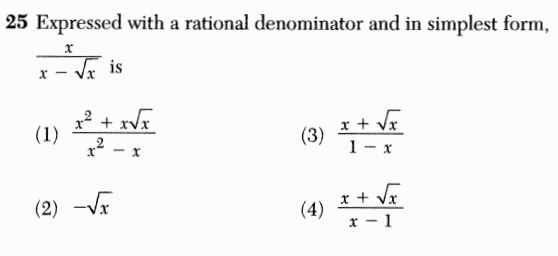Regents Recap — June 2013: Erroneous Questions, Part 2
As part of my ongoing series reviewing the NY State Regents exams in mathematics, I recently wrote about mathematically erroneous questions in the June 2013 exams.
In the original post I took issue with number 25 from the Algebra 2 / Trig Regents exam.
 I complained that the denominator here can’t really be “rationalized” since it is a variable expression. This complaint was thoughtfully refuted by a commenter who pointed out that I was thinking of the process of “rationalizing” as applying only to numbers. The process can be interpreted to apply to functions, and while I personally don’t like this use of the term, it does appear as a standard in the Alg 2 / Trig course. As a result, I withdrew my criticism and updated the post.
I complained that the denominator here can’t really be “rationalized” since it is a variable expression. This complaint was thoughtfully refuted by a commenter who pointed out that I was thinking of the process of “rationalizing” as applying only to numbers. The process can be interpreted to apply to functions, and while I personally don’t like this use of the term, it does appear as a standard in the Alg 2 / Trig course. As a result, I withdrew my criticism and updated the post.
Ironically, the commenter’s thoughtful and informed refutation actually pointed to a different reason this question is mathematically erroneous. [This emphasis here is mine.]
Admittedly, they never specify whether this expression is meant to represent a function of x or a specific number. They certainly intended the former, since they say the answer is (1) rather than (4): technically, (1) and (4) define slightly different functions (since 0 is in the domain of (4) but not (1)),while if you interpreted the original problem as a number, then (1) and (4) would define exactly the same number as you started with.
If we are talking about functions, then although (1) and (4) both appear to be equivalent to , only (1) is truly equivalent since only (1) has the same domain (
,
) as the original. The commenter argues that declaring (1) and not (4) to be the correct answer is evidence that the test-makers intended the question to be about rationalizing functions, and that they understand the mathematics of the situation.
This is an excellent point. As it turns out, however, I had mistakenly reported that (1) was the official correct answer. In fact, (4) is the official correct answer, despite the fact that it is not equivalent to the original expression (which, unlike (4), is undefined for ). Incidentally, this lack of understanding of equivalent expressions is consistently demonstrated on these exams.
Presumably, the requirement that the answer be in simplest form is what makes (4) and not (1) correct in the minds of the test-makers. But cancelling out common variable factors doesn’t just simplify expressions–it changes them by altering their apparent domains. And to me, simplest form is a characteristic of numbers only, not of expressions, which further clouds the issue of what the authors intended here.
A follow-up question might help clarify the mathematical thinking here: how would one express with a rational denominator and in simplest form?
1 Comment
Steve Kass · July 25, 2013 at 10:30 pm
“Expressed with a rational denominator” apparently means “expressed with a denominator that is a rational polynomial.” I see no reason for the question to have required students to guess this, but I don’t think interpreting “rational” as “rational number” is tenanle, since the expressions all involve x. I find the “simplest form” and carefree use if “is” issue – answer (1) vs. answer (4) – more troubling. As a college teacher, I (a college teacher) could care less if students know some arbitrary meaning of the ambiguous word “simplest.” I would like students to know which of (1)-(4) represents the same function of x as x/(x-sqrt(x)).